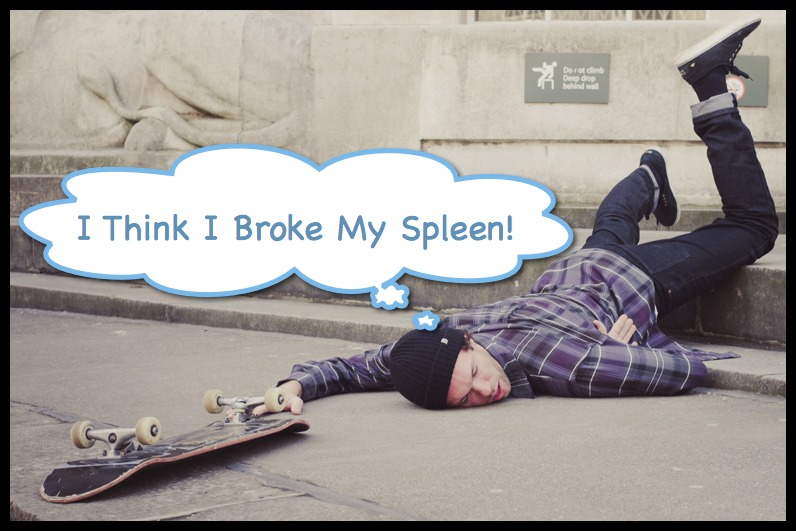Spleen Injury
Recently we discussed abusive occult abdominal injuries and how a high index of suspicion is often required as the physical exam can be misleading. The same is true with respect to accidental injuries, which are the leading cause of morbidity and mortality in children. We have discussed head injury, pulmonary contusion, aortic trauma, and traumatic pneumothorax. Now, let’s move into the abdomen and consider Splenic Injury!
Splenic Injury – Basics
- The spleen is the most commonly injured abdominal organ.
- Up to 45% of patients with blunt abdominal trauma will have splenic injury. (Costa, 2010)
- More commonly injured in school-aged children and adolescents (when dangerous activities really start).
- MVC is the most common cause of spleen injury.
- Highest mortality seen when associated with MVC and concurrent head injury.
- Mortality is as high as 12% when multi-trauma.
Splenic Injury – Presentation
- A high index of suspicion should be maintained. (Hildebrand, 2014)
- The pediatric patient’s compliant chest wall does not offer as much protection as the adult’s ribcage.
- The pediatric patient can have significant injury with minimal external signs of trauma.
- Consider Splenic Injury in:
- pt with trauma to left thorax or abdomen
- pt with hemodynamic instability (remembering that pediatric patients become hypotensive very late!!)
- pt complaining of left shoulder pain after abdominal trauma
- pt with noted rib fractures (it takes a lot of force to fracture those compliant pediatric ribs)
- pt with multi-trauma
- Unfortunately, a contained rupture may have few initial symptoms.
- Delayed presentations are not uncommon.
Splenic Injury – Grading Systems
- There are two commonly used grading systems for splenic injuries
- Neither is perfect and both require astute clinical judgement.
- American Assoication for Surgery of Trauma (AAST) Organ Injury Scale (Moore, 1989)
- I = Minor subcapsular hematoma, tear < 1cm
- II = Subcapsular hematoma 10-50% of surface, intraparenchymal hematoma < 5cm, capsular tear 1-3 cm
- III = Subcapsular hematoma >50%, intraparenchymal hematoma > 5cm, laceration >3cm or involved trabecular vessel
- IV = laceration involving segmental or hilar vessels with major devascularlization
- V = Shattered spleen or hilar vascular injury that devascularizes the spleen
- “Baltimore CT Grading System“ (Marmery, 2007)
- 1 = Subcapsular hematoma < 1 cm thick, Laceration < 1 cm deep, parenchymal hematoma <1 cm in diameter.
- 2 = Subcapsular hematoma 1-3 cm thick, laceration 1-3 cm deep, parenchymal hematoma 1-3 cm in diameter.
- 3 = Capsular disruption, Subcapsular hematoma > 3 cm thick, laceration > 3 cm deep, parenchymal hematoma > 3cm in diameter.
- 4a = Active intraparenchymal and subcapsular splenic bleeding, vascular injury (pseudoaneurysm or ateriorvenous fistula), shattered spleen
- 4b = Active intraperitoneal bleeding
- There is evidence that the “Baltimore CT Grading System” is better at predicting need for arteriography and surgery. [Marmery, 2007]
- The “Baltimore CT Grading System” has been recently advocated as helping with clinical decisions. [Olthof, 2012]
Splenic Injury: Management
- Non-operative Management
- Preferred approach if possible.
- No controversy over the lower graded injuries.
- Questions surround the higher graded injuries, but based on clinical assessment, non-op management may be feasible.
- If hemodynamically stable at 4-6 hours post injury, then splenectomy is rarely required.
- AngioEmbolization
- Consider for patients with:
- > Grade III
- Presence of contrast blush / extravasation
- Moderate hemoperitoneum
- Evidence of ongoing bleeding (i.e., decreasing Hgb levels)
- Use appears to improve organ salvage rates.
- Consider for patients with:
- Ex-Lap Salvage Techniques
- In hemodynamically stable pt, undergoing laparotomy for other injuries.
- Can apply topical hemostatic agents (ex, fibrin glue).
- Splenectomy
- Isolated splenic injury rarely requires splenectomy, but…
- Sometimes, it just has to come out.
Post-Splenectomy Concerns!
- Patients status post splenectomy are at risk for sepsis.
- Rarely occurs in patients who keep their spleen.
- Mortality from post-splenectomy sepsis ranges from 38% – 69%
- S. pneumonia is most common agent.
- Vaccinations, will have attenuated effect, but are recommended and need to be kept up to date!
- Pneumococcal Vaccine
- HiB Vaccine
- Meningococcal Vaccine
- Annual Influenza Vaccine
- Prophlyactic antibiotics
- Oral penicillin is recommended for high risk patients (ex, kids < 5 years of age)
References
Hildebrand DR1, Ben-Sassi A, Ross NP, Macvicar R, Frizelle FA, Watson AJ. Modern management of splenic trauma. BMJ. 2014 Apr 2;348:g1864. PMID: 24696170. [PubMed] [Read by QxMD]
Olthof DC1, van der Vlies CH, Scheerder MJ, de Haan RJ, Beenen LF, Goslings JC, van Delden OM. Reliability of injury grading systems for patients with blunt splenic trauma. Injury. 2014 Jan;45(1):146-50. PMID: 23000055. [PubMed] [Read by QxMD]
Costa G1, Tierno SM, Tomassini F, Venturini L, Frezza B, Cancrini G, Stella F. The epidemiology and clinical evaluation of abdominal trauma. An analysis of a multidisciplinary trauma registry. Ann Ital Chir. 2010 Mar-Apr;81(2):95-102. PMID: 20726387. [PubMed] [Read by QxMD]
Marmery H1, Shanmuganathan K, Alexander MT, Mirvis SE. Optimization of selection for nonoperative management of blunt splenic injury: comparison of MDCT grading systems. AJR Am J Roentgenol. 2007 Dec;189(6):1421-7. PMID: 18029880. [PubMed] [Read by QxMD]
Moore EE1, Cogbill TH, Jurkovich GJ, Shackford SR, Malangoni MA, Champion HR. Organ injury scaling: spleen and liver (1994 revision). J Trauma. 1995 Mar;38(3):323-4. PMID: 7897707. [PubMed] [Read by QxMD]
Moore EE1, Shackford SR, Pachter HL, McAninch JW, Browner BD, Champion HR, Flint LM, Gennarelli TA, Malangoni MA, Ramenofsky ML, et al. Organ injury scaling: spleen, liver, and kidney. J Trauma. 1989 Dec;29(12):1664-6. PMID: 2593197. [PubMed] [Read by QxMD]



[…] Certainly, we are aware of the potential injuries that come with activities like fireworks or skateboarding, but the summertime water activities bring their own unique issues like submersion injuries or […]
[…] have discussed pediatric trauma several times within the PedEM Morsels (Splenic Injury, Head Injury, Pneumothorax, etc), because it is often a source of trepidation, confusion and […]